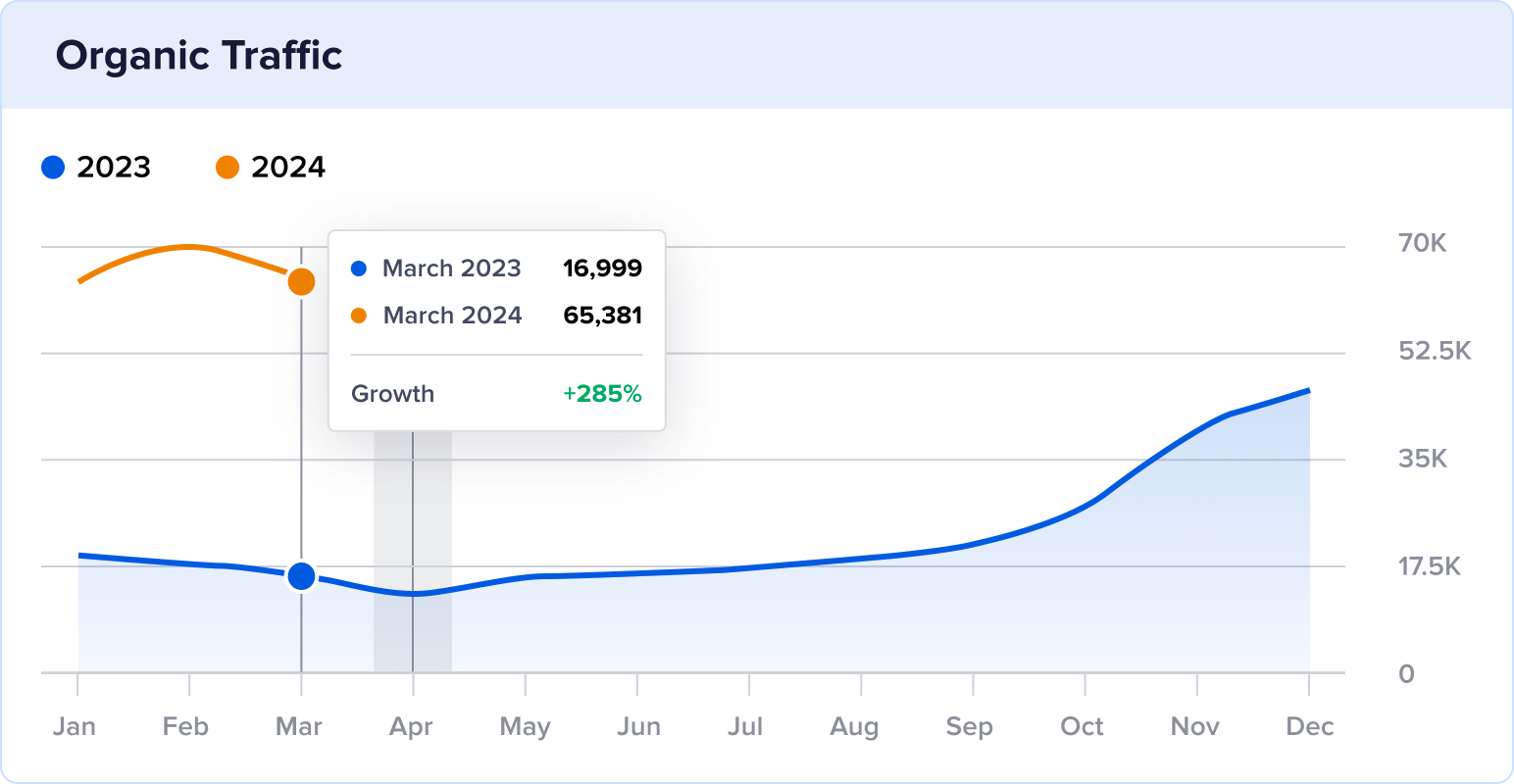How an American Food Blog Grew Traffic by 195% in 7 Months
https://alexandracooks.com/
Stats
249.8K to 736.6K Monthly Visits
Industry
Food & Drink
Niche
Food Blog
Reporting Date
December 2023
In 2024, food blogs remain the most lucrative niche in the blogging world.
Why?
People love food. And it’s one of the easiest subjects to monetize.
But standing out in a crowded digital kitchen isn’t easy for even the most experienced bloggers.
In this SEO case study, we’ll explore the growth journey of Alexandra’s Kitchen, a US-based food blog that’s been around for over 17 years.
They ended 2023 with a bang, boasting 736K monthly visits, and we’re sharing they did it. Plus, you’ll get tips for replicating their success on your blog.
Let’s get started.
In This Article
About Alexandra’s Kitchen
Alexandra Stafford started her food blogging journey in 2006.
In her personal and professional life, Alexandra was no stranger to the kitchen.
She grew up in a home with a vibrant kitchen and from-scratch recipes. After college, she went to culinary school and spent several years working in restaurant kitchens. She was also a regular contributor to Food52, a popular online community for foodies worldwide.
Alexandra’s Kitchen is a place to share all her favorite recipes, seasonal ingredients, and love of bread.
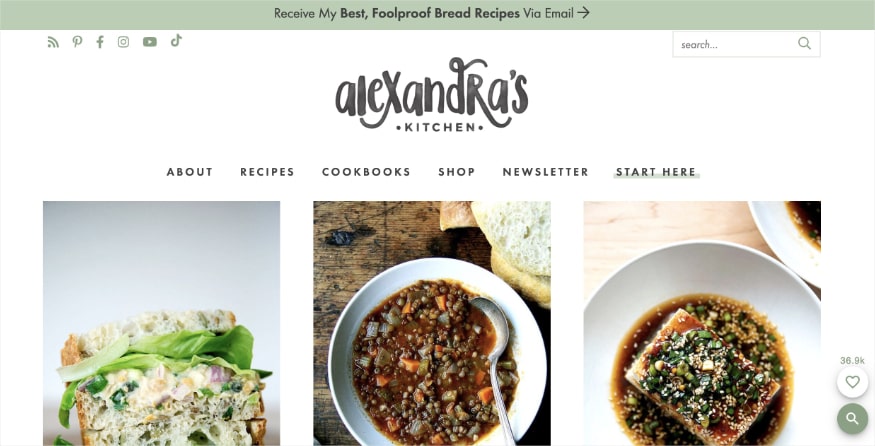
Like most food blogs, Alexandra organizes her content by recipes. Users can also filter them by:
- Type
- Season
- Diet
- Ingredient
She also has a convenient Recipe Index, which organizes all her content into one place. (It’s also a great spot for internal linking!)
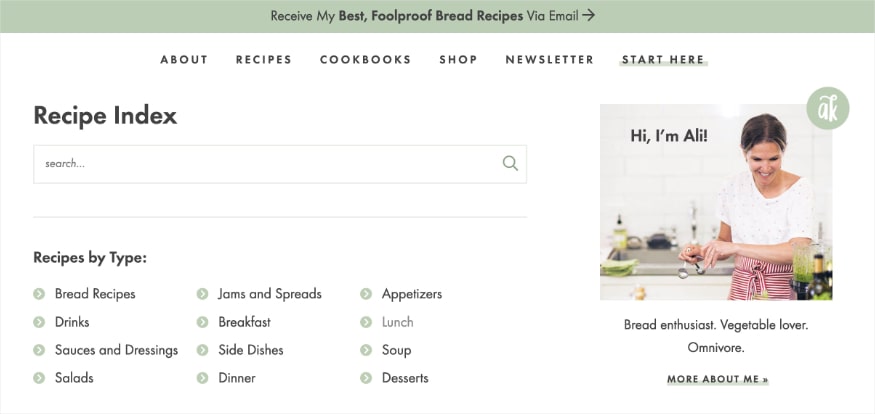
Alexandra, or Ali for short, has written two cookbooks since launching Alexandra’s Kitchen.
Both are available to purchase on her blog, alongside her favorite cooking products (many of which are affiliate links).
Historical Performance
Despite its 17-year online presence, Semrush only stores historical metrics for 10 years. For this reason, we’ll focus on the last decade of Alexandra’s Kitchen.
From 2012 to mid-2019, Alexandra’s Kitchen averaged 18K monthly organic visits.
Traffic started to pick up near the end of 2019 and took off in 2020.
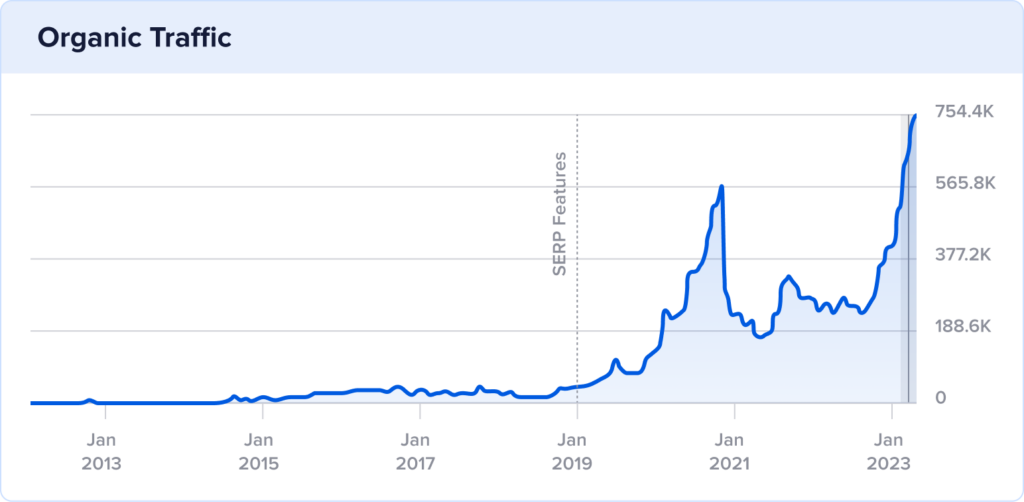
From 2020 through 2021, Alexandra’s Kitchen experienced its first real growth in traffic. They averaged almost a quarter million monthly visits (242K) during this time.
This growth aligns with the COVID pandemic when many people cooked at home.
If you remember the baking bread trend, it was also in full swing at this time. (And Ali’s blog had several bread-making blogs ready to appease these new home bakers.)
In May 2020, her beginner’s guide to making sourdough bread was her website’s #1 visited page.
Once the pandemic had subsided and ovens cooled down, traffic averaged 270K monthly visits from 2022 to April 2023.
Then, in May, Alexandra’s Kitchen began entering its next phase of growth.
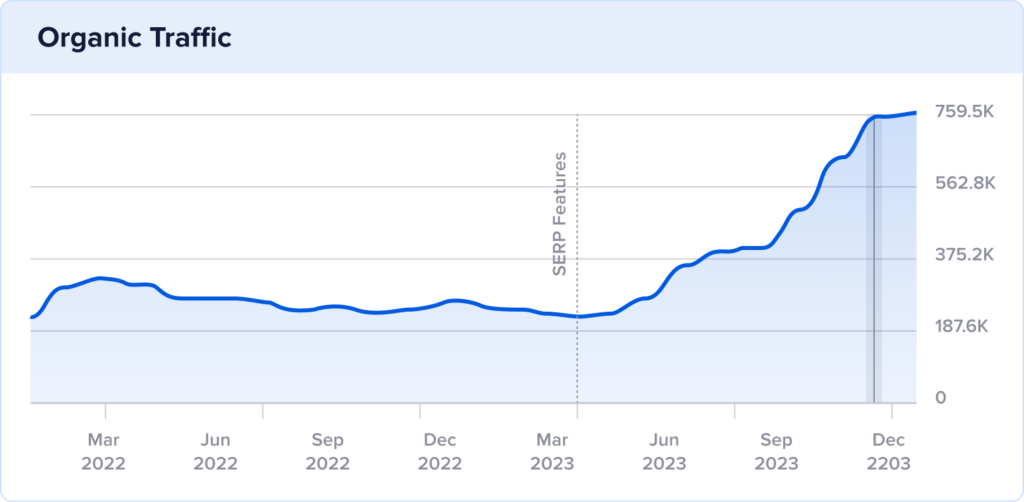
Organic traffic has been steadily increasing, with December 2023 reaching a new record high: 736K organic visits.
So, how did Alexandra’s Kitchen finally crack the code to take her blog to the next level?
We’re revealing those strategies next.
The Catalyst: How Alexandra’s Kitchen Reached 736K Monthly Visits
Alexandracooks.com grew its organic traffic by performing the following:
- Generating fresh recipes for fresh content
- Optimizing for recipe and review snippets
- Engaging with her social media audience
Let’s explore each point to understand how they contributed to the blog’s growth (and how they can help yours, too).
1. Generating Fresh Recipes for Fresh Content
In 2023, Ali added 32 new recipes to the website.
These were easy to uncover since Ali uses dating conventions in her URLs.
https://alexandracooks.com/2023/04/15/simple-no-knead-rye-bread/This cadence is a steady output when you’re running a blog solo. That’s 2-3 blogs every month.
In these articles, Ali goes into great detail.
The image below shows how she organizes her content into different sections, making it easier for readers to digest and follow along.
(For bloggers, this is a great strategy for optimizing your content for readability. This tactic encourages users to stay on your post for longer.)
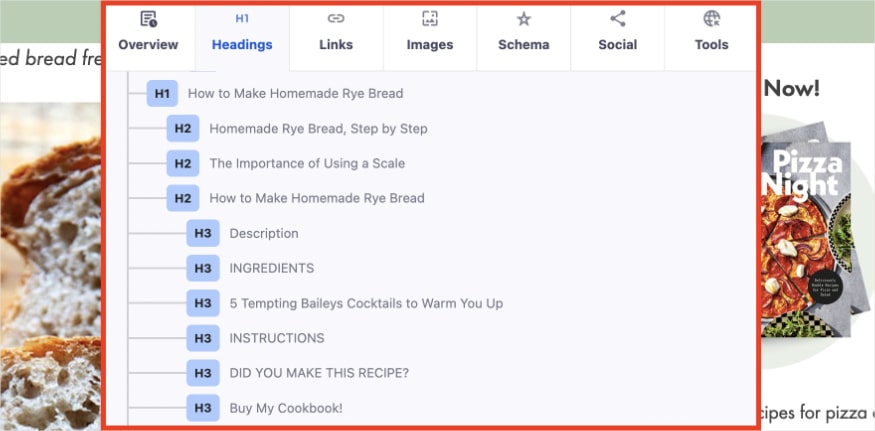
Note: The above screenshot was taken from the All in One SEO Analyzer. This free Chrome Extension makes it easy to analyze competitors’ websites or your own.
In these comprehensive posts, Ali leverages multimedia to keep her audience engaged.
Images help users visualize the cooking steps, and Ali demonstrates what the food item should look like.

She also embeds helpful YouTube videos to aid users in the baking process.
For example, the video below demonstrates how to shape the dough for a loaf pan.

After guiding her audience through the full recipe, Ali ends each post with a recipe card.

Comments are enabled below the post, and Ali responds to almost all of them. She answers queries about ingredient alternatives, helps users troubleshoot any issues, and provides general appreciation to those sharing positive feedback.
It’s a refreshingly honest exchange that’s genuine and engaging.
Why this matters:
Ok, so you may be wondering why we took you through all that, but it’s important to understand how much work goes behind each of these blog posts.
Ali is incredibly thorough in her approach and focuses on high-quality, helpful content above all else. (And good, seasonal ingredients!)
Her content output aligns with the effort that goes into each recipe.
As for search engines, Ali’s fresh, new recipes are critical for maintaining content freshness.
Content freshness measures how new or recently updated your content is.
Search engines love fresh content.
And the more search engines like your content, the better your chances at ranking.
That’s why it’s important to keep your website fresh and relevant with updated posts or new content at all times.
How to maintain freshness on your site:
You need to combat content decay to maintain freshness.
Content decay is the natural decline in the performance of old content.
This in-depth tutorial shows you how to prevent content decay, but here’s an overview of the process:
- Refresh old content.
- Maintain and add internal links.
- Check posts for changes in search intent.
- Prune irrelevant pages.
- Consolidate content.
- Expand your existing content.
- Promote your content.
Tools for content freshness:
One of the easiest ways to maintain freshness and monitor content decay is by using the All in One SEO (AIOSEO) plugin.
The Search Statistics module helps you catch performance slips. Then, you can take the necessary steps to reinvigorate your content.
With Search Statistics, you’ll get two reports that make this process seamless:
- The Content Performance Report tells you which page is dropping in performance.

2. The Keyword Rankings Report tells you which keywords are on the decline.
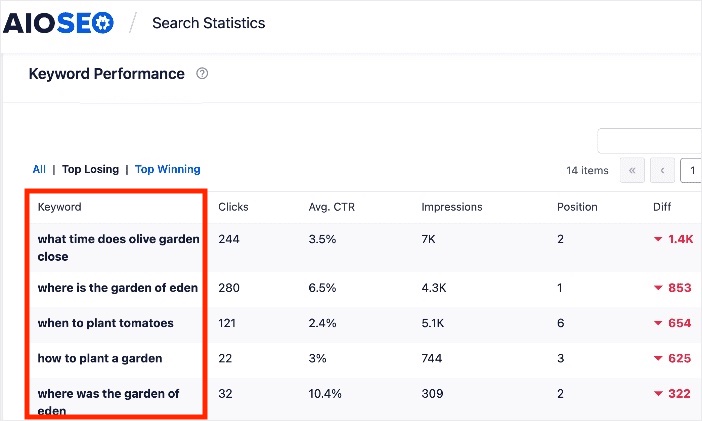
Both reports provide quick and comprehensive insights to stay on top of your content’s organic performance, so you don’t have to chase after their metrics.
Next, let’s look at Ali’s technical optimizations to make her blogs stand out in search results.
2. Optimizing for Recipe Snippets
If you’ve ever browsed for a recipe online, chances are you’ve encountered a recipe snippet.
Recipe snippets showcase helpful cooking information on the SERP, like cooking time, nutritional information, and more.
Below is an example of a recipe snippet from Alexandra’s Kitchen.

And here’s the same recipe featured in Google’s recipe carousel:
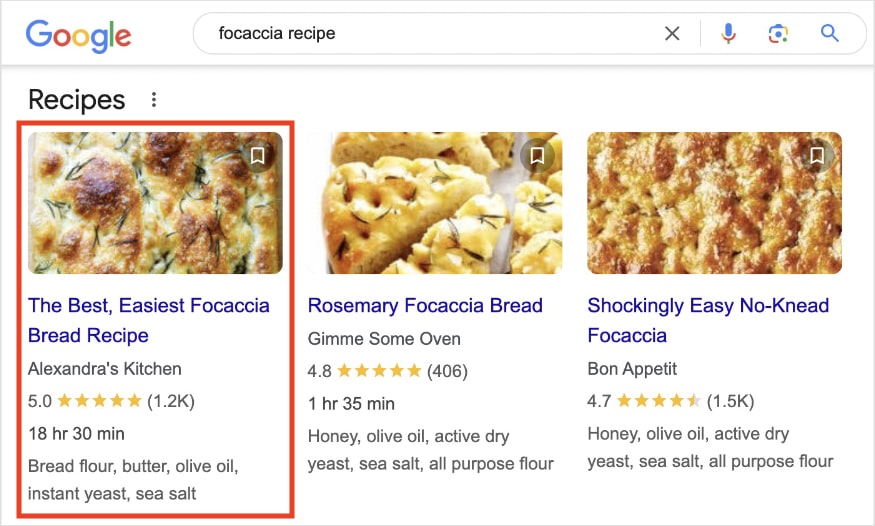
At the end of 2023, recipe snippets were Alexandra’s Kitchen’s most prominent SERP feature.
They won 18.3K recipe snippets in December.

It’s also important to note that these recipe snippets are also considered review snippets.
Alexandra’s Kitchen implements recipe and review schema markup (we’ll show you how shortly) and wins rich results for both.
Review snippets show the average rating of scores from users. You’ll most often see this on the SERP as stars, as shown below.

In December 2023, Alexandra’s Kitchen won 185K review snippets.
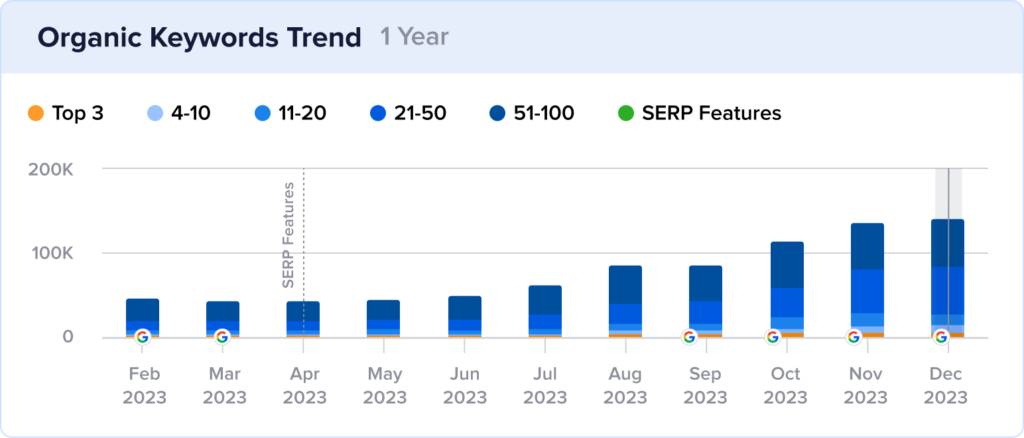
Why this matters:
Rich results boast an impressive clickthrough rate (CTR) of 58%.
This is significantly higher than non-rich results, which have a 41% CTR.
Given their performance on the SERP, prioritizing rich results is crucial. Any blog aiming to secure increased visibility and more traffic should optimize for them.
Now, let’s get to the part you’ve been waiting for—how to get these kinds of rich results.
How to win recipe snippets for your site:
Schema markup is the #1 thing to do to win rich results (plus having killer content, of course).
Schema markup is a type of code that lives in the backend of your website. It communicates important details about your page to search engines.
Search engines can then use this information to generate a rich result on the SERP.
Note: Implementing schema markup does not guarantee a search result but increases the likelihood. It’s also considered an SEO best practice.
There are many types of schema markups, each with a different purpose.
Alexandra’s Kitchen uses the following:
As for implementing it on your website, there are a few different ways to do it.
If you choose the manual route, this tutorial shows you how to implement schema markup without a plugin. The tutorial gives you three different methods, each requiring you to obtain code snippets. Then, you’ll paste them into the appropriate fields in WordPress.
For a streamlined route, we recommend using a schema markup plugin.
Let’s look at which one we recommend next.
Tools for schema markup:
AIOSEO has rich snippet schema that makes formatting structured data a breeze. In fact, you don’t have to format it at all.
Just pick the schema type you want, and we’ll format it for search engines for you.
Below is the AIOSEO Schema Catalog, which includes recipe schema.

Once you’ve clicked the Plus button, we’ll walk you through easy-to-fill-in fields. You can set your dish type, add an image, and include details like nutritional information and cooking time.
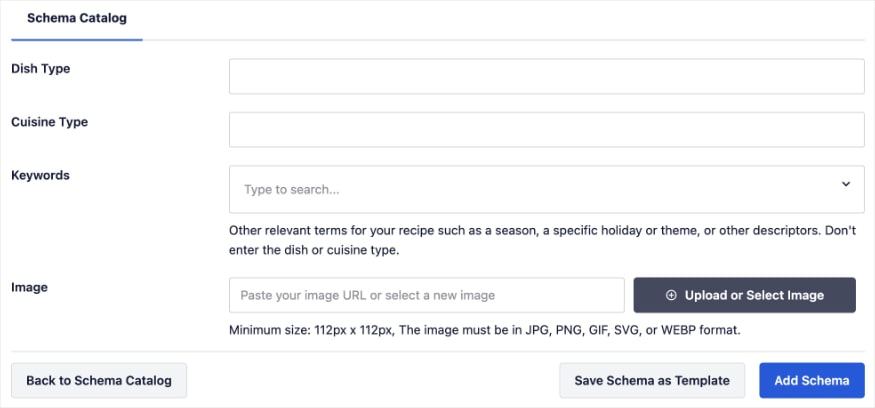
Now that we know how Ali (1) creates great content and (2) supports it with technical SEO, let’s look at how she promotes it.
3. Engaging With Her Social Media Audience
Once Ali has a new blog post, she doesn’t wait for search engines to bring the traffic.
Instead, she takes a proactive approach and promotes her latest content to her followers.
Here’s a breakdown of her most popular social media platforms and their follower count:
- Instagram: 970K (multi-million videos – 1 has over 14M)
- TikTok: 606.8K (lots of videos have multi-million views)
- Pinterest: 184.9K
- YouTube: 59.1K
- Facebook: 36.8K
Instagram and TikTok are her most active accounts, and she posts videos regularly on both.
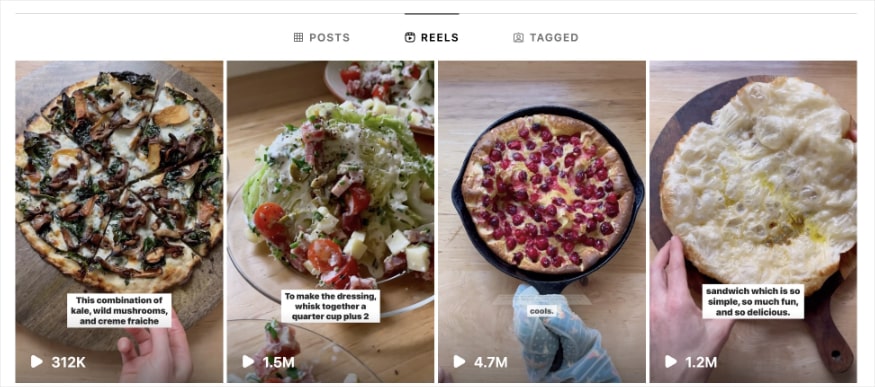
Many of Ali’s videos go viral.
It’s not uncommon for them to get multi-millions of views. In fact, on Instagram, they’re the regular.
With that said, she still has some recipes that stand out against the rest.
This Instagram reel for a lemon-blueberry Dutch baby recipe got 50.9 million views.
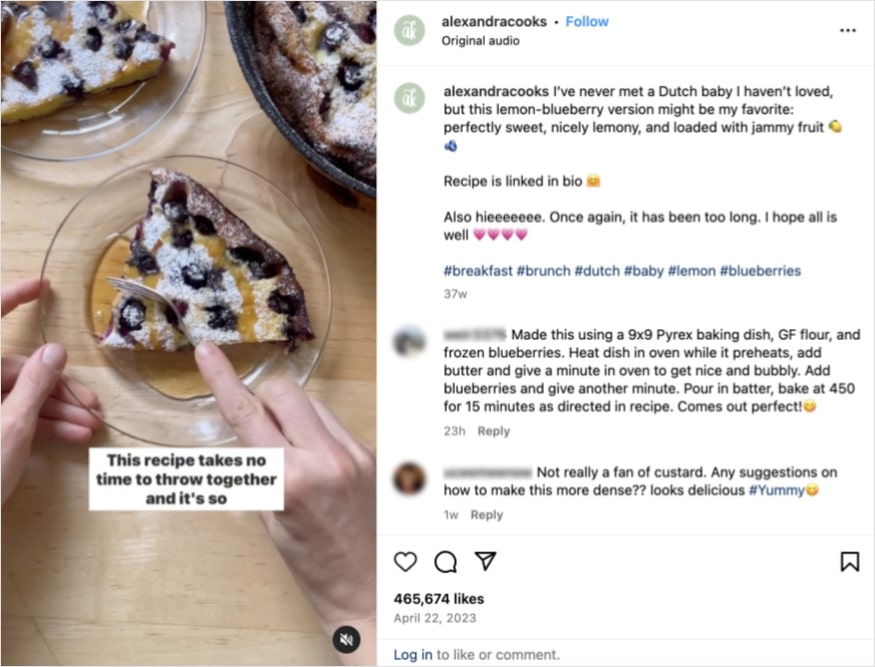
Ali links the recipe in her bio, driving traffic to her blog.
Another unique approach by Ali is incorporating a page dedicated to links for her social media accounts.
For example, the page below organizes all her TikTok links in one place (hello, more internal links!).

She does the same for Instagram, as well.
Why this matters:
For website owners, social media is a powerful tool to extend your reach. It allows you to stay connected to your existing followers and meet new users. This helps boost brand awareness and build a stronger online presence.
How to promote content on social media:
Follow Ali’s lead and promote new content on your social media accounts. You should also link to this content in your profile.
You can share a link in bio in Instagram and TikTok or share a link in the post on a Twitter card, LinkedIn post, etc.
Social media plugins can streamline this process, so let’s look at our recommended plugin next.
Tools for social media integration:
AIOSEO features a social media integration that makes sharing your content a breeze. You can add up to 11 social media accounts, covering all your social needs.
Here are just a few things you can do with AIOSEO’s social media tools:
- Set up default thumbnail images for Facebook
- Integrate with Facebook insights
- Generate post titles automatically using smart tags
- Customize and preview Twitter cards
- And more
Check out the available network integrations below:
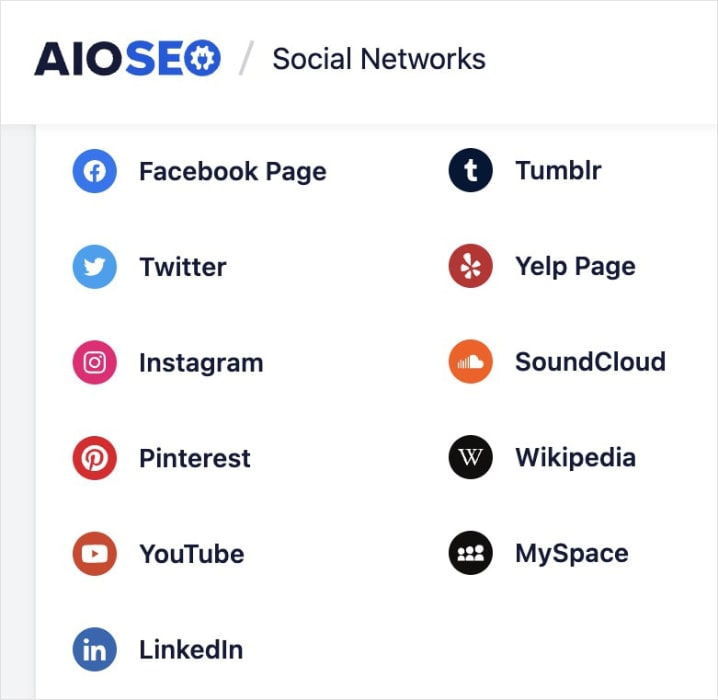
Standout SEO Wins
Before we wrap up, there’s another technique worth highlighting at alexandracooks.com.
1. They have XML and RSS sitemaps.
Search engines use sitemaps to understand your website.
XML sitemaps list all your pages. It acts like a roadmap for search engines, guiding them through all of your website’s content.
On the other hand, RSS sitemaps list the URLs of all new or recently updated pages. This means it will be a shorter list than the XML sitemap. It’s also faster for search engines to crawl.
Google recommends both XML and RSS sitemaps for optimal crawling.
Alexandra’s Kitchen follows this SEO best practice.
Tool: AIOSEO generates both XML and RSS sitemaps automatically for you. This is the default setting, meaning you don’t have to do anything to get them.
You can also view each sitemap (as shown below) and alter their settings if you wish.

Takeaways
In our analysis of alexandracooks.com, we’ve been impressed with Ali’s comprehensive recipes with a focus on seasonal ingredients. She’s cultivated a rich community of followers and has earned recognition from The New York Times, Bon Appetit, Saveur, and more.
Now, let’s recap which of her strategies can be used to grow your blog traffic and others to reconsider.
Top 3 Strategies to Emulate
- Fight content decay with fresh content. Search engines love fresh content. You can ensure your site stays relevant by updating existing content and publishing new content. This proactive approach keeps users engaged with up-to-date information and helps your rankings.
- Implement schema markup to stand out on the SERP. Search engines use schema markup to display rich results on the SERP. Food blogs should implement recipe and review schema, like Alexandra’s Kitchen. There are also several other types to create attractive search listings that win more clicks and traffic.
- Leverage social media to connect with your audience and new users. Ali actively engages with her audience across several platforms. This helps her build meaningful connections with her followers and boost brand awareness. You, too, should promote new content on your social media accounts and share their links to drive more traffic to your site.
Bottom 3 Strategies to Reconsider
- Some URLs are very long. Some of Alexandra’s Kitchen’s URLs are very long and include dates. You should future-proof URLs by not including dates. You’ll also want to simplify them for clarity. In general, the shorter, the better. Don’t forget to include your keyword, too! The TruSEO tool checks your URLs for optimizations and lets you know if you forget your primary keyword.
- There are missing meta descriptions. Every indexable page on your site should have a meta description. This text acts like a preview to users viewing your search result and lets them know what to expect from your page. The more compelling it is, the more clicks and traffic you’ll drive to your site. You can use a meta description generator to write click-worthy text automatically.
- Neglecting image titles. Image titles appear when users click or hover over an image. They can be helpful for users looking for more information or context. They also help search engines better understand your image, thus increasing its chances of ranking in Google Images. With the Image SEO tool, you can streamline image optimizations and generate titles automatically.
Steal Our SEO Winning Strategy: A Checklist for Your Website
Are you ready to get your blog noticed?
This SEO Checklist has all the optimizations you need to take over the SERP and get more eyes on your content.
Download A Free SEO Checklist
Access our comprehensive SEO Checklist with a single click. We’ll deliver it straight to you, putting actionable items with SEO tools and tutorials right at your fingertips.
Enter your name and email to download a free SEO checklist.
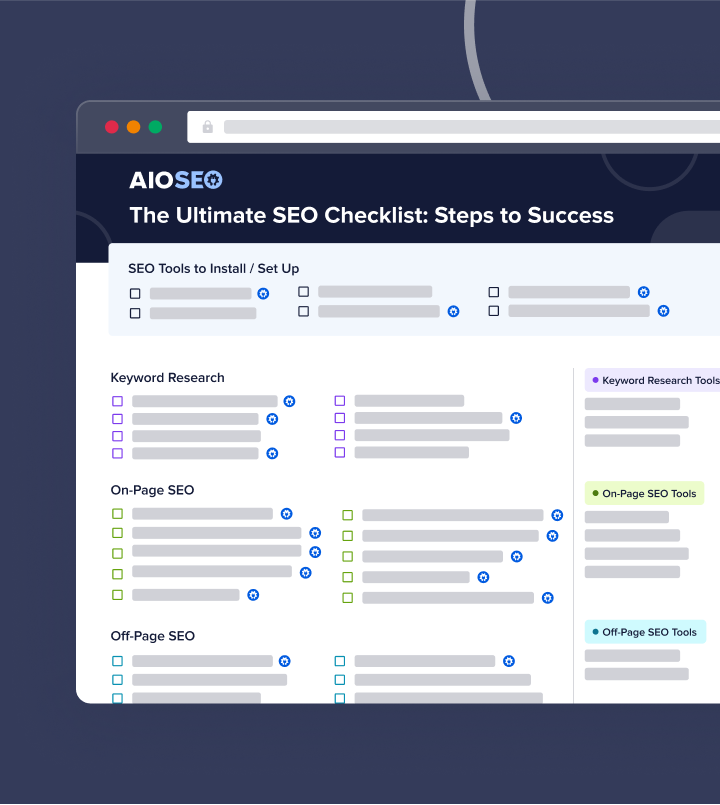
Win Higher Rankings and More Blog Traffic With AIOSEO
What if you could skip some of the legwork and enjoy streamlined optimizations that work?
AIOSEO helps you do just that—rank higher and faster.

All in One SEO is the best WordPress SEO plugin on the market. You’ll get a full suite of tools that are easy to use and make a difference. Whether you’re a brand-new blogger, a seasoned pro, or somewhere in between, AIOSEO was designed to make SEO easy so you can get back to doing what you do best—creating great content.
Here are some features you’ll love:
- Search Statistics: Keep an eye on your website’s organic performance with comprehensive and easy-to-understand reports. Search statistics include content decay tracking, so you know exactly when a page starts to slip, allowing you to fix it.
- Rich Snippets Schema: AIOSEO offers various schema markup options to help you claim more rich results on the SERP. It’s as simple as choosing the schema you want; then, we’ll format the structured data for Google.
- Social Media Integration: Seamlessly connect your social media platforms and share content with your audience. Available integrations include Facebook, Instagram, Twitter, LinkedIn, Pinterest, YouTube, and more.
- XML and RSS Sitemaps: Sitemaps help search engines understand and navigate your website. XML sitemaps include all your pages, while RSS sitemaps list new and updated content for faster crawling. AIOSEO generates both sitemaps for your website automatically.
- AI Title & Description Generator: This time-saving tool creates compelling metadata for any page on your site. With the click of a button, you’ll harness the power of AI and get options for unique meta titles and descriptions.
- Link Assistant: Get link suggestions, edit anchor text, and add internal links to your content in just 1 click. Link Assistant makes your internal linking strategy more effective than ever and keeps your blog interconnected.





